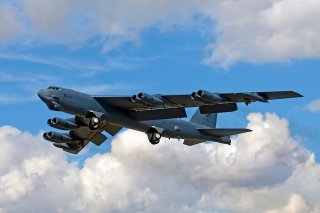America’s B-52J Nightmare is Just Starting
The current variant, the B-52H, has been in service since 1961—meaning it has seen combat in every war or campaign from the Vietnam War to Desert Storm to the conflicts in Afghanistan and Iraq.
America’s iconic B-52 Stratofortress first took wing during the halcyon days of the Truman administration. A long-range nuclear bomber that was designed to counter what was then the immense and growing nuclear threat that the Soviet Union posed to the United States, it has transitioned over the decades to a multirole platform capable of both conventional and nuclear missions. These behemoths have seen action in basically every post-World War II confrontation the United States has engaged in.
The current variant, the B-52H, has been in service since 1961—meaning it has seen combat in every war or campaign from the Vietnam War to Desert Storm to the conflicts in Afghanistan and Iraq.
A new variant is in the offing, one which will totally knock the proverbial socks off the Air Force’s bomber jockeys and strategists alike. That’s the B-52J. Three key elements undergird the B-52J project. The B-52 is getting a new lease on life that will extend its service to our country until the middle of the century, effectively ensuring that the warplane will have served for a century.
That is truly incredible (and a shot across the bow at the fantasists who currently control U.S. defense policy, who seem to think that the newer, more complex, and costlier the plane, the better).
The Upgrades
But the Stratofortress will continue proving its worth with the Air Force’s three major upgrades to the bird’s engines, its avionics and sensors, and enhancements to its overall structure to make it more relevant to the modern (and evolving) battlefield.
As for the most important upgrade for the B-52J variant, its new engines, these things are really the crux of the entire enhancement. The old engines were the Pratt & Whitney TF33s. These aging engines have been replaced by brand, sparkling new (and powerful) Rolls-Royce F130 engines.
With these engines come greater fuel efficiency, reduced maintenance requirements, and overall better performance over the older Pratt & Whitneys. Of note, the engines grant the B-52J better takeoff and climb capacity, which are crucial in the kind of contested battlespaces these birds will be operating in over the next several decades.
The B-52J will feature a new Raytheon AN/APG-79B4 Active Electronically Scanned Array (AESA) radar, replacing the older mechanically scanned arrays, thereby increasing the aircraft’s situational awareness and targeting capabilities. Upgrades also include brilliant new communication systems, glittering cockpit displays, and an overall streamlining of onboard functions (one of the crew stations has been removed for the new B-52s).
All the aforementioned upgrades prioritize data networking and cross-integration with friendly combat platforms in any engagement. In other words, network-centric warfare comes to the B-52 with a vengeance.
Structural modifications were made to the airframe of the new B-52J to make it more relevant in modern combat scenarios. For instance, the Air Force removed some of the sensor pods to reduce drag and improve flight performance. The Pentagon then doubled down on its investment in defensive systems for these flying juggernauts, making it possible for them to avoid grisly fates at the hands of the vastly improved anti-aircraft systems of near-peer rivals, like those of China and Russia (should direct conflict with either of those powers ever occur).
Upgrades are Behind Schedule
Sadly, there is no program the Pentagon can take on today that won’t be met with abysmal delays, complications, and ghastly cost overruns. The B-52J is no different. Initial engine testing of the Rolls-Royce F130s was supposed to take place at the end of 2023. But these were delayed. Not only have there been delays with the engines, but there were serious complications with the fancy new software upgrades on the bird.
John A. Tirpak of the Air & Space Forces Magazine, reported last month that on December 13, “the Rolls Royce F130, has cleared its critical design review, meaning it can enter final development, test, and production on time.” Although, Tirpak assesses that the overall program is “still three years behind.” So, rather than starting ground and flight tests around 2028, the B-52J is unlikely to start real testing until around 2033.
Of course, these developments will only complicate America’s already flagging air warfare abilities as we enter into a period of severe great power competition that may result in another world war. The jury is still out as to whether the Air Force will even be able to meet the expected number and deployment timeline for this most important system.
Brandon J. Weichert, a Senior National Security Editor at The National Interest as well as a Senior Fellow at the Center for the National Interest, and a contributor at Popular Mechanics, consults regularly with various government institutions and private organizations on geopolitical issues. Weichert’s writings have appeared in multiple publications, including the Washington Times, National Review, The American Spectator, MSN, the Asia Times, and countless others. His books include Winning Space: How America Remains a Superpower, Biohacked: China’s Race to Control Life, and The Shadow War: Iran’s Quest for Supremacy. His newest book, A Disaster of Our Own Making: How the West Lost Ukraine is available for purchase wherever books are sold. He can be followed via Twitter @WeTheBrandon.
Image: Andrew Harker / Shutterstock.com

